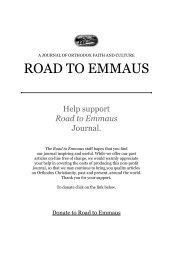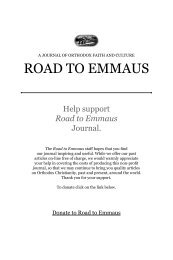RTE No 20 Interior - Road to Emmaus Journal
RTE No 20 Interior - Road to Emmaus Journal
RTE No 20 Interior - Road to Emmaus Journal
You also want an ePaper? Increase the reach of your titles
YUMPU automatically turns print PDFs into web optimized ePapers that Google loves.
the as<strong>to</strong>nishing missionary journeys of the apostle andrewAccording <strong>to</strong> Epiphanius, 4 a ninth-century monk his<strong>to</strong>rian ofConstantinople, St. Andrew also went north of China, <strong>to</strong> the land of theScythian Massagetae and Masakas (the cradle of the Bulgarians and Turksat the junction of present day Mongolia, Kazakhstan and Altai), the Pro<strong>to</strong>-Bulgarian tribes, the Ungric and Trocharians, and also <strong>to</strong> the mountains ofKalbin in Altai, Siberia.The route from Sogdiana <strong>to</strong> the land of the Massagetae was a route thatRomans, Jews, and Greeks didn’t use. It was a road that the nomadic tribesused when they collected payments from the Chinese for protecting the Silk<strong>Road</strong>. Regional traditions say that St. Andrew was there, and he seems <strong>to</strong>have been accepted by these nomads, who were considered <strong>to</strong> be some of themost savage people of that time. I don’t think he was treated badly, becausethere are no records of misadventures in these places. This was easternScythia, not western Scythia which was Ukraine and Russia, and theChinese were very afraid of the eastern Scythians. The Trocharians wholived here were <strong>No</strong>rdic, white people with blue eyes, blond hair and redbeards who were living in China and in Mongolia.<strong>RTE</strong>: A decade ago I saw people like that a little further north near theMongolian border in Altai, Siberia. Along with the Altai who have obviousMongol roots, they are a second native ethnic group. The Russians call them“Turks,” although they know they aren’t from Turkey, <strong>to</strong> differentiate themfrom the Mongolians and Chinese.GEORGE: Yes, exactly. These people moved up in<strong>to</strong> Altai through Mongolia.They were from below Kalbin, in northern Asia.<strong>RTE</strong>: I was recently <strong>to</strong>ld by a woman from the Urals that there is a widespreadSiberian tradition that St. Andrew preached as far north as the present-dayvillage of Kazanskoe in the Russian Urals, and prophesied that therewould be widespread Christianity there someday. The village has a churchdedicated <strong>to</strong> him.4Hieromonk Epiphanius: Ninth century his<strong>to</strong>rian and priestmonk of Moni Kallistra<strong>to</strong>n in Constantinople, whowrote a life of Saint Andrew: “Epiphanii Monachi et Presbyteri – de Vita et Actibus et Morte Sancti, et PlaneLaudandi, et Primi Vocati Inter Apos<strong>to</strong>los Andrae” [in P.G. Migne, vol. 1<strong>20</strong>]. He is also the author of the oldestextant Life of the Theo<strong>to</strong>kos (P.G. Migne, vol. 1<strong>20</strong>.). Epiphanius deeply venerated St. Andrew and tried <strong>to</strong>recreate his journeys based on ancient sources. Traveling extensively in the areas St. Andrew was known <strong>to</strong>have been, he gathered many local traditions and texts connected with the apostle’s missionary journeys. It wasa magnificent work for his era. Some of his passages concerning the martyrdom of St. Andrew are identical withthe apocryphal “Acts of Andrew,” and it is very likely that he also used Leucius Charinus’ text.29










